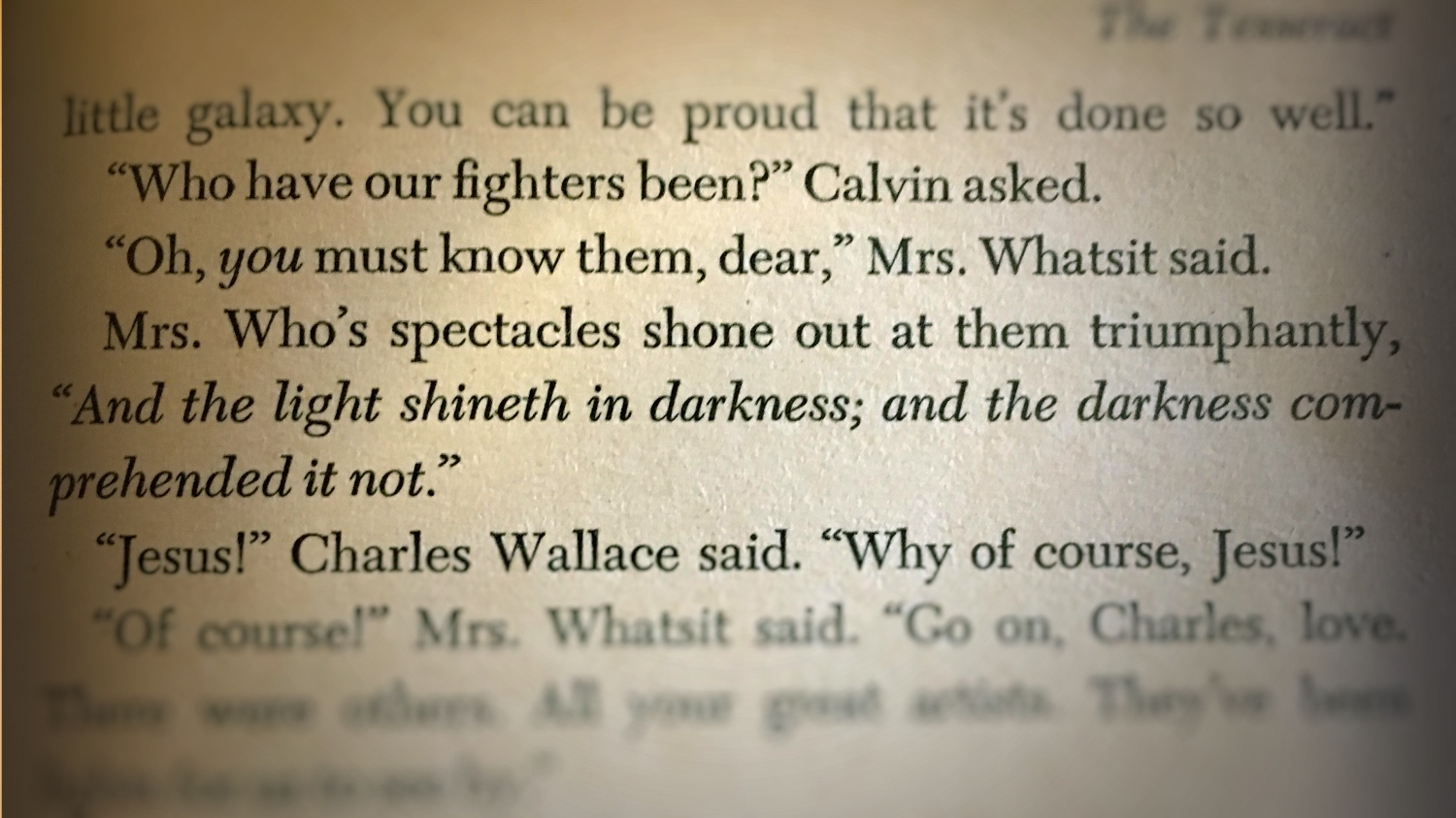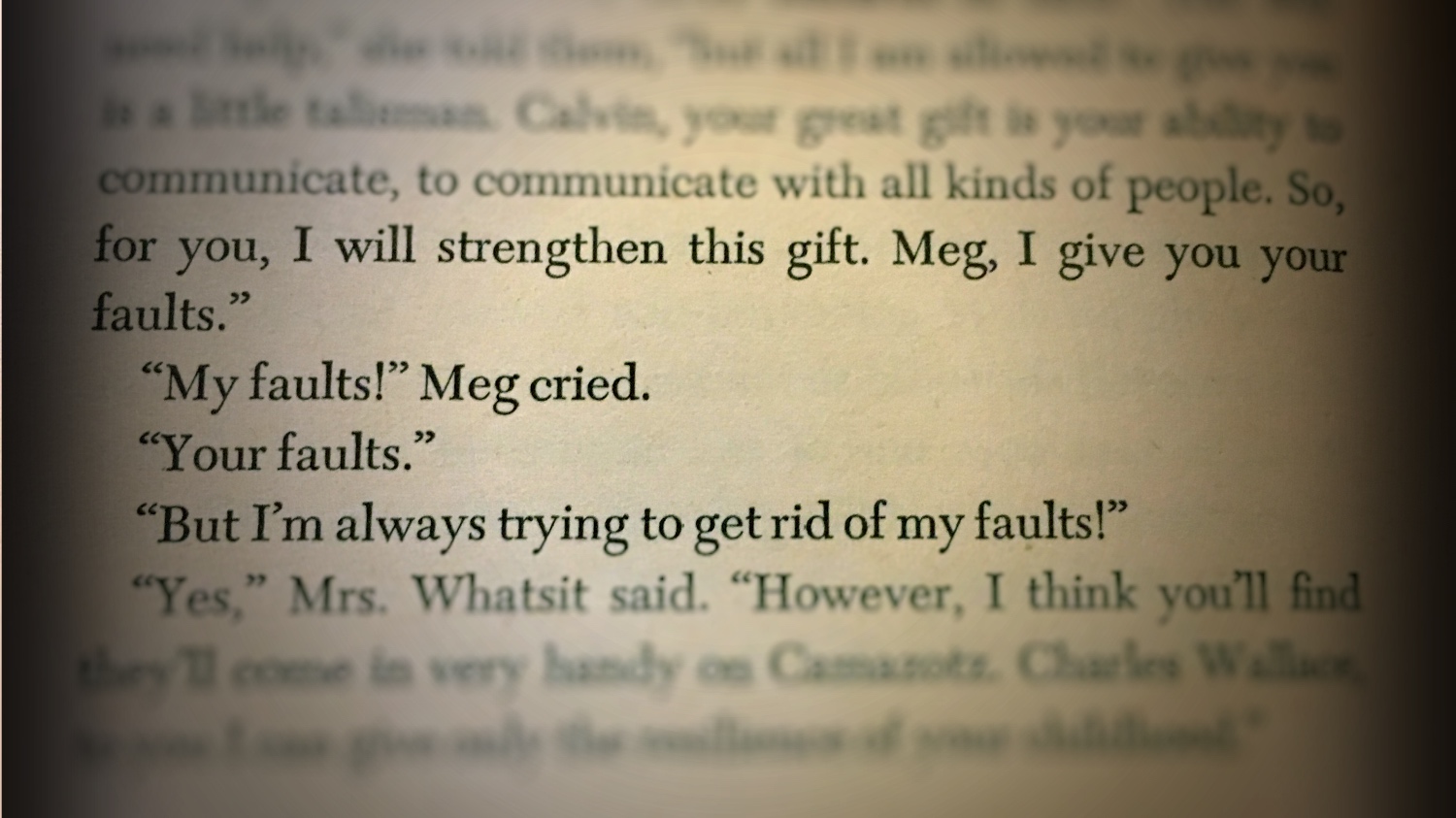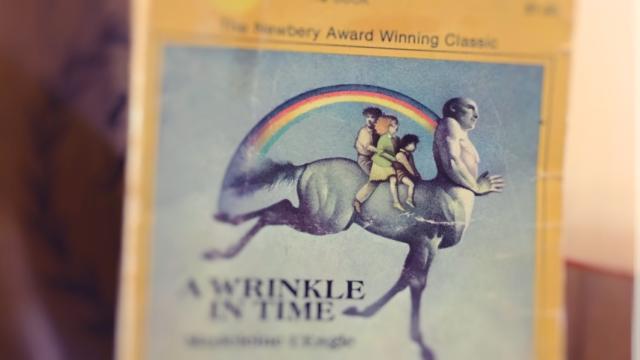It’s been about 15 to 20 years since I’ve read Madeleine L’Engle’s A Wrinkle in Time. I’ve carried the 1962 novel with me throughout my entire life. It’s travelled across four state moves, from coast to coast, forever a reminder of the girl I once was and the person I became. Now, as director Ava DuVernay defines her vision of the scifi novel on the big screen, I’ve decided to look back at the book that helped define me. (And I knew exactly where on my bookshelf it was.)

Photo: Beth Elderkin
I don’t remember how old I was when I first read A Wrinkle in Time. I think around seven or eight years old – at least, that’s what my mother said after I talked with her on the phone about it last week. I will say, one of the weirdest things you can do as an adult is ask your parents about what you were like when you were a kid. It’s kind of surreal. You’re tapping into something both familiar and strange, seeing your own history reflected back at you through expert eyes. Sometimes, you hear that little sigh as they travel back in time to when you were half their height and squealing you’d just learned what a fragrance is.
Talking to my mum about my old reading habits is especially fascinating, as I was one of those kids whose main ways of rebelling was sneaking a flashlight bookmark into bed with me. Reading was my thing. But according to my mum, I didn’t just read A Wrinkle in Time, I “breathed it in.”
For those who haven’t read it or want a reminder, A Wrinkle in Time is a 1962 novel about an intelligent but complicated girl named Meg Murry whose scientist father has been missing for years, with town gossip assuming he abandoned his family. However, three celestial beings – going by the names Mrs. Which, Mrs. Who, and Mrs. Whatsit – reveal that her father is being held captive by a mysterious “IT.” Meg, along with her genius brother Charles Wallace and their new friend Calvin, must travel to a dangerous world of mass conformity in order to rescue him.
A Wrinkle in Time is about 55 years old at this point, and its legacy is largely positive, but still mixed. It’s praised for helping girls embrace their love of fantasy and science fiction and explore STEM fields in ways they hadn’t been encouraged to before. However, it’s also pretty dated, and gets criticised for its overt religious themes. Some say L’Engle’s Christian faith is too ingrained in the book’s message, making it seem preachy at times. Some even believe Charles Wallace is an allegory for Jesus Christ, though I tend to disagree with that one.

Photo: Beth Elderkin
As a young girl, those praises and criticisms didn’t factor in for me. I can definitely see them now, as an adult, after rereading the book for the first time in years. But nostalgia is a tricky thing: You don’t just see what the book is, but what it used to be. For you, specifically. No one else. This isn’t an excuse, and people’s views shouldn’t stagnate over childhood things when challenged by outside perspective. But it is an interesting phenomenon all the same. Nostalgia shapes our worldviews more than we – I would care to admit. It’s part of the reason why some fans have a hard time embracing new interpretations of their beloved works. I’ve even seen a few people upset that Meg Murry is biracial in DuVernay’s film, claiming the character is supposed to be white – even though her ethnicity wasn’t specified by the author, only on the book cover.
Perspective and criticism aside, there’s something about this book that still gives me a warm feeling of childlike hope inside my gut, even though I’m 32 years old at this point and supposedly ready to have kids of my own. So, what made this book such a beloved part of my life and identity, to the point where I’ve kept it with me all these years? Why is A Wrinkle in Time my most nostalgic treasure? Well, it wasn’t the encouragement into STEM, as evidenced by my work. Nor the nods to religion – the fact that I soon followed up with Phillip Pullman’s His Dark Materials can attest to that. It wasn’t even because I was dipping my toes into science fiction and fantasy, even if those later became my favourite genres. No…
…it was because of Meg’s faults.

Photo: Beth Elderkin
Growing up, Meg’s flaws were my flaws. I felt them like a second skin. Meg talked about not being able to hide her emotions like her mother, bemoaning that she always showed “everything.” As did I. Meg overly leaned on others even as she pushed them away. I did too. Like her, I was passionate, honest, and stubborn. I was also self-critical, believing the worst things about myself even though I was a bright child. All in all, Meg Murry didn’t see herself as the hero of her own story. I didn’t either.
When I was young, Meg Murry was a character I could identify with, possibly for the first time in my life. I looked at this flawed, beautiful child and saw my own reflection in her frustrated thoughts and stomping feet. Every time she picked a fistfight with a boy, or yelled at her father when he couldn’t solve all her problems, I was there in those pages. But slowly, as the novel went on, Meg began to grow. So, I did too. She may have stumbled sometimes, but she was always moving forward. Toward… well, I didn’t really know at the time. Toward something. I assumed it was the climax, saving her family. But it was also something else.
I didn’t realise it at the time, but A Wrinkle in Time wasn’t just a reflection on my own girlish insecurities, it was also preparing me for something: Womanhood.
One time when I was a teenager, probably around 14 years old, I remember walking into my parents’ closet, sitting down, and bursting into tears. I can’t remember what about – honestly, it probably doesn’t matter – but I distinctly remember feeling strange and isolated from my peers, and eager to have all my loves, fears, and emotions explained away. What is wrong with me? I thought over and over. Why is this all so much? My parents came to comfort me and I looked to them for answers, only to feel hurt and betrayed when they didn’t have what I thought I needed.
I’ve been reliving this uncomfortable but poignant memory ever since I re-read the section after Meg was attacked by IT and rendered comatose. After going into an infant-like state and being nursed to health by an alien named Aunt Beast, Meg’s first need was to have her father explain away all her worries about leaving her brother behind. What is wrong with me? She’d think over and over. Why do I have to do so much? He tried, but the answers weren’t up to him. That moment when Meg realises that she’s the only one who can save Charles Wallace… it was like the first moment I realised I had answers of my own. At one point, both of us grew up. Not in spite of our flaws, but because of them.
Becoming a woman is weird. It’s awkward, and messy, and emotional. A combination of personal stress and societal pressure make you see yourself as alone, with unforgivable faults that no one else could have or understand. But I wasn’t alone. I had Meg. A Wrinkle in Time was readying me to face the world with my faults intact, unafraid to embrace my strengths and weaknesses… even when they weren’t understood. I was an weirdo, yes, but that wasn’t something to fear. Her oddness didn’t hold her back. It wouldn’t hold me back either.
This is why A Wrinkle in Time is still on my shelf, decades later, outliving and outlasting almost everything else in my life. Growth and perspective may have changed how I interpret the book, but it’s still a beloved part of who I was, am, and continue to be. And I’m excited for a whole generation of girls to experience that for themselves, through the eyes of a woman who not only created new worlds, but also brought to life the story of mine.
